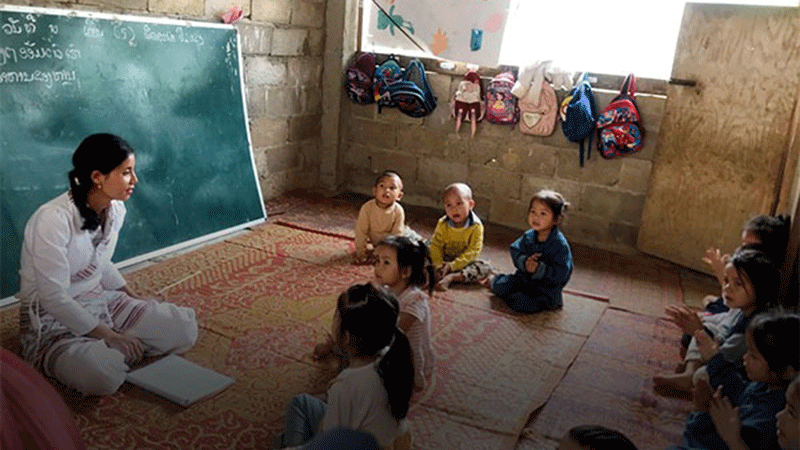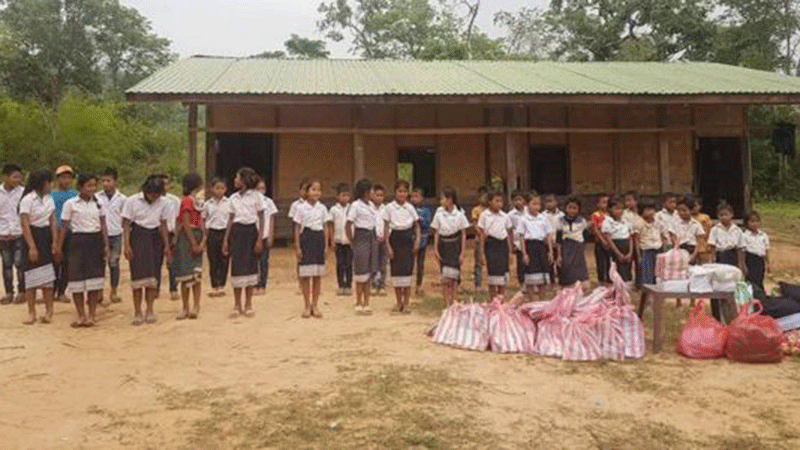 |
A volunteer teacher with her kindergarten class in a rural area of Phongsaly province. (File photo Vietiane Times) |
Military personnel fill the gap caused by teacher shortage
The government’s deployment of military personnel to address the ongoing teacher shortage in remote areas is proving to be both timely and effective.
One key benefit of this initiative is its flexibility. For instance, if a teacher in a rural school must take time off because of illness, maternity leave, or personal matters, trained army staff temporarily step in as substitute teachers for the required period.
The main reason for the shortage of both government-appointed and volunteer teachers at schools in remote areas is the difficult living conditions, such as a lack of electricity, running water, internet access, and roads. These schools are typically situated in border zones or mountainous regions, making travel difficult and discouraging many from accepting or maintaining teaching positions.
 |
A school in a remote area of Laos. --Photo Military News |
Data gathered by education authorities in six northern provinces reveal that these conditions are also a key factor contributing to student dropout rates.
“Due to remoteness and poor access, many teachers simply do not want to work in such areas,” an education official said.
A second major issue is the rising cost of living. While expenses continue to rise, incomes remain stagnant, resulting in a lack of motivation among teachers and reduced enthusiasm for education among students.
Thirdly, there is an imbalance in teacher allocation. Urban areas tend to have an excess of teachers, with some classrooms having two to three teachers, while rural schools often lack even one full-time teacher. As a result, mixed-grade classrooms are common, which significantly affects the quality of education.
Savannakhet province has more than 2,000 schools, ranging from kindergarten to secondary, but only 8,000 teachers. Of these, 1,600 are volunteer teachers, meaning that on average, each school is staffed by just four teachers.
To address these critical challenges, the government has issued a resolution outlining policies and measures to resolve the teacher shortage, reduce dropout rates, and promote vocational education.
Under this resolution, the Ministry of National Defence and the Ministry of Education and Sports have been tasked with working together to recruit and train new teaching personnel.
The Ministry of National Defence is responsible for identifying and selecting military personnel who meet the criteria and are willing to undergo short-term teacher training for primary education.
Meanwhile, the Ministry of Education and Sports is requesting existing volunteer teachers to formally join the military, with the aim of recruiting 2,000 individuals.
Once recruited, these volunteer teachers will receive support under army regulations, including salaries and benefits. But military personnel participating in the programme will receive an additional 70 percent of their basic salary.
This initiative aims not only to address the pressing issue of teacher shortages in rural areas but also to reduce student dropout rates and formalise the role of long-serving volunteer teachers who have yet to be officially integrated into the education system.
Following the successful deployment of the first batch of trained personnel, the two ministries ran a short training course for military and education officials at Luang Prabang Teachers’ College, which took place from June 27-July 5.
The 63-hour course covered the basics of subjects taught at primary schools, including Lao language, maths, science, and writing. The 93 attendees were divided into three groups of 31.
By investing in both education and national service, the government is finding innovative ways to bridge the gap in rural education while strengthening community resilience and national development.
By Khonesavanh Latsaphao
(Latest Update July 15, 2025)
|



